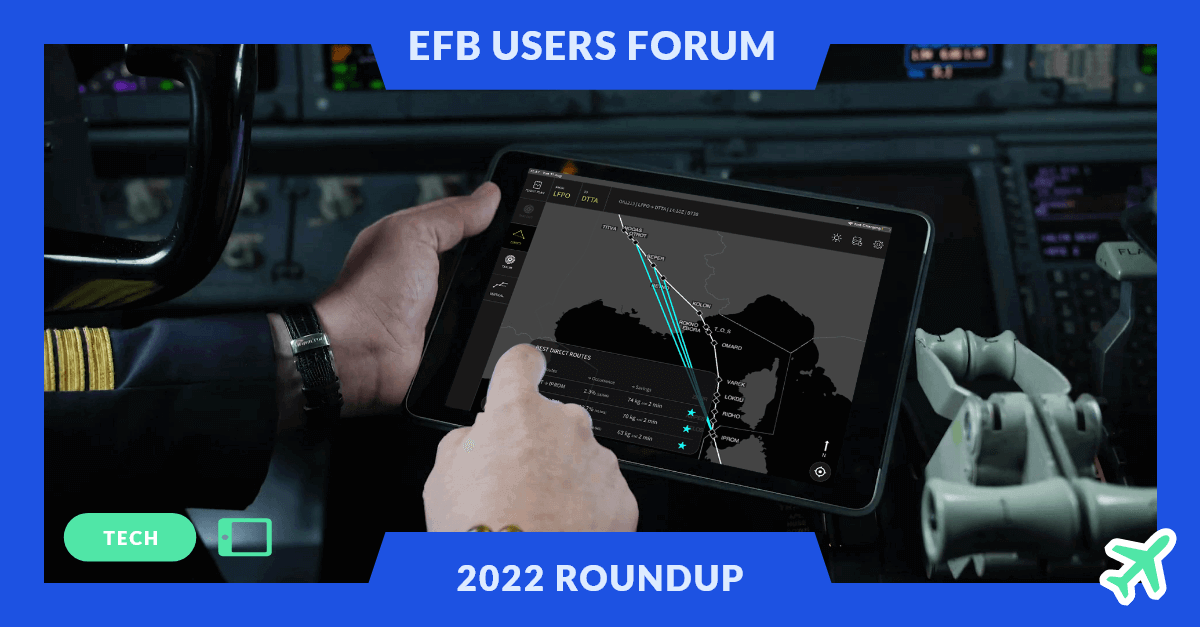The latest trends from the Electronic Flight Bag Users Forum 2022
At last, after months of canceled events and virtual conferences, things are finally looking up for trade show exhibitors and visitors!
Earlier this month, we attended the Electronic Flight Bag Users Forum hosted by Collins Aerospace that took place from June 1st to June 3rd in Annapolis, Maryland, USA.
The forum brings together avionics professionals specialized in cockpit applications since 2010. It is organized by ARINC Industry Activities, a program that aims to set aviation technical standards and encourage the development of innovative solutions. Following last year’s event that took place as a virtual conference due to Covid-19, we were very pleased to travel to Annapolis and meet again in person!
For the 300 visitors who attended the forum, it was the chance to attend four conference sessions, stroll through the exhibitor’s expo, and exchange views about the latest developments, the next challenges, and the future of the Electronic Flight Bag ecosystem.
In a post-pandemic context and following the “Great Resignation” movement in the US, we’re ready for a new take-off! In a nutshell, we talked about extracting value from data, taking advantage of the connectivity, and of course, focusing on environmental sustainability. It is indeed urgent to decarbonize aviation. That’s why reducing fuel consumption and CO2 emissions should be at the center of innovation.
What’s new in the Electronic Flight Bag ecosystem?
Regulation
Here are the latest updates on both FAA and EASA standards. Those organizations are civil aviation authorities from respectively the United States and Europe. Their role is to define rules for the airline industry, ensuring safety and efficiency.
- On the EASA side, the reference document is known as SPA.EFB.100, a document initially published in 2019. The last updates are about displaying the aircraft position on aircraft moving maps and weather maps. Weather conditions are increasingly featured in EFB applications and are expected by the final users: the pilots.
- On the FAA side, the reference document is known as AC 120-76D, which public version should be released in the next 2-3 months. In the talks, they mentioned cyber security risks assessment, digital interactions with Air Traffic controllers (e.g.: research on taxi instructions), datalink real-time weather in the cockpit…
Security and connectivity
Airplanes are getting increasingly connected through various systems (Wifi, SATCOM, ACARS…), and data is more abundant and available via devices such as AID. In this context, it is important to create a secured interconnected ecosystem, through standards definition and secured design.
Integrated EFB
- Data collection is crucial for raising pilots’ awareness of fuel consumption through smart integration in their EFB. Getting fresh, up-to-date in-flight data such as weather, turbulences or NOTAMs would help application providers, airlines, ATC, flight planners, and pilots make great progress in terms of fuel efficiency. For instance, Skybreathe® OnBoard direct assistant evaluates shortcut opportunities and savings considering actual weather conditions to help pilots save time and fuel, both in one single initiative!
- Pilots’ engagement was also central to the discussions. At the end of the day, they are the end-users of the applications so making sure they use and enjoy the tool is paramount. This topic raised many questions: how to encourage pilots’ adoption? What are the best ways to involve them? How to introduce change?
During the testimonial sessions, operators emphasized the importance of adopting an incremental approach centered on the end-user. The idea is to display accurate and useful information in a simple way rather than showing layer-cake meaningless charts. A well-designed app should allow pilots to see their application rate of fuel efficiency best practices at a glimpse and easily compare their performance to the rest of the crew (of course with anonymized data).
These practices recommended by operators are at the core of SkyBreathe® MyFuelCoach pilot assistant, confirming that it followed a relevant approach over the past 8 years.
LEARN MORE
Want to go further and learn how a live assistant could help your pilots save time and fuel?
Read the article >> Fly shorter with directs: an effective way to improve fuel efficiency


